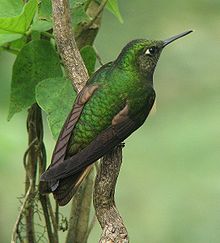Boissonneaua
| Boissonneaua | |
|---|---|

| |
| Buff-tailed coronet, Boissonneaua flavescens | |
| Scientific classification | |
| Domain: | Eukaryota |
| Kingdom: | Animalia |
| Phylum: | Chordata |
| Class: | Aves |
| Clade: | Strisores |
| Order: | Apodiformes |
| Family: | Trochilidae |
| Tribe: | Heliantheini |
| Genus: | Boissonneaua Reichenbach, 1854 |
| Type species | |
| Trochilus flavescens[1] Loddiges, 1832
| |
| Species | |
|
3, see text | |
Boissonneaua is a small genus of hummingbirds in the family Trochilidae. They are found in humid Andean forests from western Venezuela to southern Peru. They have a straight black bill, contrasting outer rectrices, and a distinctive habit of quickly lifting both wings up shortly after landing, thereby revealing their rufous underwing coverts.
Species[edit]
The genus contains three species:[2]
| Common name | Scientific name and subspecies | Range | Size and ecology | IUCN status and estimated population |
|---|---|---|---|---|
| Chestnut-breasted coronet | Boissonneaua matthewsii (Bourcier, 1847) |
Colombia, Ecuador, and Peru.
|
Size: Habitat: Diet: |
LC
|
| Buff-tailed coronet | Boissonneaua flavescens (Loddiges, 1832) Two subspecies
|
Colombia, Ecuador, and Venezuela.
|
Size: Habitat: Diet: |
LC
|
| Velvet-purple coronet | Boissonneaua jardini (Bourcier, 1851) |
western Colombia and north-western Ecuador.
|
Size: Habitat: Diet: |
LC
|
References[edit]
- ^ "Trochilidae". aviansystematics.org. The Trust for Avian Systematics. Retrieved 2023-08-05.
- ^ Gill, Frank; Donsker, David; Rasmussen, Pamela, eds. (July 2020). "Hummingbirds". IOC World Bird List Version 10.2. International Ornithologists' Union. Retrieved 2 January 2020.
- Restall, R., Rodner, C., & Lentino, M. (2006). Birds of Northern South America. Vol. 1 & 2. Helm, London. ISBN 0-7136-7242-0 (vol. 1); ISBN 0-7136-7243-9 (vol. 2).



